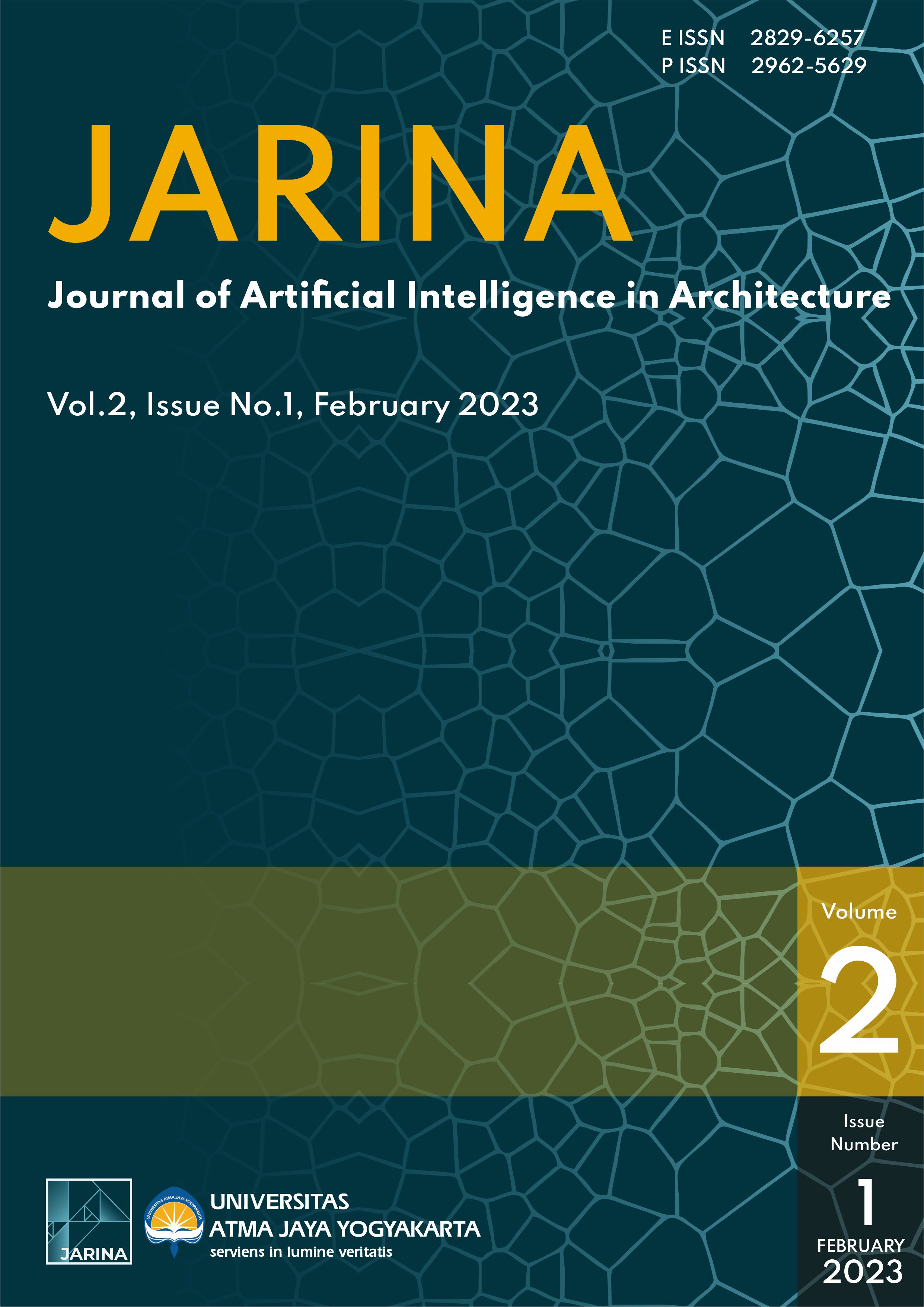A Review of AI Image Generator: Influences, Challenges, and Future Prospects for Architectural Field
DOI:
https://doi.org/10.24002/jarina.v2i1.6662Keywords:
AI Image Generator, Text-to-image, Neuroarchitecture, Influence, Challenge, ProspectsAbstract
Recently, the topic of text-to-image-based GAI (Generative Artificial Intelligence) or AI Image Generators became so popular because of its sophistication in creating images based on human natural language messages in a short time. On the other hand, the presence of the AI Image Generator is enough to reap various opinions, including in the field of architecture. Therefore, the purpose of this paper is to present a review of the influences, challenges, and prospects of AI Image Generator technology in the architectural design process. The research method used is a systematic literature review by reviewing 12 scientific articles, five books, and five official websites. The results of the study explained that the AI Image Generator could provide one step forward to expanding the design imagination by presenting several design alternatives with high-quality visuals. The challenge lies in the user's proficiency in providing text commands that AI programs can detect. The prospect of this program, if developed in more depth, is to become a rendering tool that can release dependence on devices with high specifications and additional editing applications.
References
Mambang et al., “Rancang Bangun Alat Musik Tradisional Berbasis Android,” Jurnal Nasional Komputasi dan Teknologi Informasi (JNKTI), vol. 5, no. 2, pp. 149–154, Apr. 2022, Accessed: Dec. 09, 2022. [Online]. Available: https://www.ojs.serambimekkah.ac.id/jnkti/article/view/4036
M. G. Gunagama and N. F. Lathifa, “Automatictecture : Otomatisasi Penuh Dalam Arsitektur Masa Depan,” Jurnal Arsitektur NALARs , vol. 16, no. 1, pp. 43–60, 2017.
G. Rahayu Meliani and A. Suryadi, “Game Artificial Intelegent Ram City Tower Dengan Algoritma A,” Jurnal PETIK, vol. 3, no. 2, p. 31, Sep. 2017.
R. A. Putra, “Peran Teknologi Digital Dalam Perkembangan Dunia Perancangan Arsitektur,” Elkawnie: Journal of Islamic Science and Technology, vol. 4, no. 1, pp. 67–78, 2018, [Online]. Available: www.jurnal.ar-raniry.com/index.php/elkawnie
S. Chaillou, “ArchiGAN: Artificial Intelligence x Architecture,” in Springer Architectural Intelligence, 2020, pp. 117–127. doi: 10.1007/978-981-15-6568-7_8.
Basuki and L. Purwanto, “Perkembangan Arsitektur Digital Dan Dynamic Living,” Jurnal Ilmiah Arsitektur, vol. 12, no. 1, pp. 12–20, 2022, [Online]. Available: https://ojs.unsiq.ac.id/index.php/jiars
M. Maganga, “The AI Image Generator: The Limits of the Algorithm and Human Biases,” ArchDaily, Nov. 2022. Accessed: Dec. 09, 2022. [Online]. Available: https://www.archdaily.com/992012/the-ai-image-generator-the-limits-of-the-algorithm-and-human-biases
J. L. Stone, “We ‘Designed’ Buildings Using an AI Image Generator—Here Are the Bizarre Results,” METROPOLIS, Jul. 2022. https://metropolismag.com/viewpoints/midjourney-architecture-image-making/ (accessed Dec. 09, 2022).
N. Tiku, “AI can now create any image in seconds, bringing wonder and danger,” The washington Post , Sep. 28, 2022. https://www.washingtonpost.com/technology/interactive/2022/artificial-intelligence-images-dall-e/ (accessed Dec. 10, 2022).
L.-H. Lee et al., “When Creators Meet the Metaverse: A Survey on Computational Arts,” When Creators Meet the Metaverse: A Survey on Computational Arts. ACM Comput. Surv, vol. 37, no. 111, p. 36, Nov. 2021, doi: 10.48550/arxiv.2111.13486.
C. Ambrosio, “Unsettling robots and the future of art,” Science (1979), vol. 365, no. 6448, pp. 38–39, Jul. 2019, doi: 10.1126/SCIENCE.AAY1956.
D. Carter, “Ai-Da creates the first portrait of the Queen painted by a humanoid robot | Creative Boom,” Creative Boom, Jun. 01, 2022. https://www.creativeboom.com/news/ai-da-queen/ (accessed Dec. 09, 2022).
J. Lewis, “Create art the AI way,” Mid.Day, Sep. 25, 2022. https://www.mid-day.com/sunday-mid-day/article/create-art-the-ai-way-23247382 (accessed Dec. 09, 2022).
A. Borji, “Generated Faces in the Wild: Quantitative Comparison of Stable Diffusion, Midjourney and DALL-E 2,” ArXiv, Oct. 2022, Accessed: Dec. 10, 2022. [Online]. Available: https://www.researchgate.net/publication/364126542_Generated_Faces_in_the_Wild_Quantitative_Comparison_of_Stable_Diffusion_Midjourney_and_DALL-E_2
H. Hassanzadeh, “How MidJourney And DALL·E 2 Help Designers to Create Unique Concepts?,” Parametric Architecture, Aug. 15, 2022. https://parametric-architecture.com/how-midjourney-and-dalle-2-help-designers-to-create-unique-concepts/ (accessed Dec. 09, 2022).
Z. Huang, “Analysis of Text-to-Image AI Generators,” United States , 2022. [Online]. Available: https://www.assemblyai.com/blog/how-dall-e-2-actually-
S. A. D. Popenici and S. Kerr, “Exploring the impact of artificial intelligence on teaching and learning in higher education,” Research and Practice in Technology Enhanced Learning 2017 12:1, vol. 12, no. 1, pp. 1–13, Nov. 2017, doi: 10.1186/S41039-017-0062-8.
T. R. Kelley and J. G. Knowles, “A conceptual framework for integrated STEM education,” Int J STEM Educ, vol. 3, no. 1, pp. 1–11, Dec. 2016, doi: 10.1186/S40594-016-0046-Z/TABLES/4.
K. Tommy, “Robot Cerdas Sophia Ngaku Tak Bisa Jadi CEO, Ini Alasannya,” Liputan 6, Jakarta, Sep. 16, 2019. Accessed: Dec. 12, 2022. [Online]. Available: https://m.liputan6.com/bisnis/read/4063720/robot-cerdas-sophia-ngaku-tak-bisa-jadi-ceo-ini-alasannya
Jamaaludding and Sulistyowati Indah, Buku Ajar Kecerdasan Buatan. Sidoarjo: UMSIDA PREDD, 2021.
H. Jaya, Sabran, M. Idris, A. Y. Djawad, Ilham, and A. S. Ahmat, Kecerdasan Buatan, Pertama. Fakultas MIPA Universitas Negeri Makassar, 2018.
A. Sawhney, M. Riley, and J. Irizarry, CONSTRUCTION 4.0. New York: Routlege, 2020.
K. Havik, “Acts of Symbiosis: A Literary Analysis of the Work of Rogelio Salmona and Alvar Aalto,” Montreal Architectural Review, vol. 4, Dec. 2017, Accessed: Dec. 12, 2022. [Online]. Available: https://mar.mcgill.ca/article/view/31
M. Mazzone and A. Elgammal, “Art, Creativity, and the Potential of Artificial Intelligence,” Arts 2019, Vol. 8, Page 26, vol. 8, no. 1, p. 26, Feb. 2019, doi: 10.3390/ARTS8010026.
H. Navidan et al., “Generative Adversarial Networks (GANs) in networking: A comprehensive survey & evaluation,” Computer Networks, vol. 194, p. 108149, Jul. 2021, doi: 10.1016/J.COMNET.2021.108149.
A. Singh, V. Jaiswal, G. Joshi, A. Sanjeeve, S. Gite, and K. Kotecha, “Neural Style Transfer: A Critical Review,” IEEE Access, vol. 9, pp. 131583–131613, 2021, doi: 10.1109/ACCESS.2021.3112996.
L. A. Gatys, A. S. Ecker, and M. Bethge, “A Neural Algorithm of Artistic Style,” ArXiv Cornell University, vol. 2, Aug. 2015, [Online]. Available: http://arxiv.org/abs/1508.06576
J. Agnese, J. Herrera, H. Tao, and X. Zhu, “A survey and taxonomy of adversarial neural networks for text-to-image synthesis,” Wiley Interdiscip Rev Data Min Knowl Discov, vol. 10, no. 4, p. e1345, Jul. 2020, doi: 10.1002/WIDM.1345.
T. Qiao, J. Zhang, D. Xu, and D. Tao, “Mirrorgan: Learning text-to-image generation by redescription,” Proceedings of the IEEE Computer Society Conference on Computer Vision and Pattern Recognition, vol. 2019-June, pp. 1505–1514, Jun. 2019, doi: 10.1109/CVPR.2019.00160.
S. Ajay Bankar and S. Ket, “An Analysis of Text-to-Image Synthesis,” in International Conference on Smart Data Intelligence (ICSMDI), 2021. [Online]. Available: https://ssrn.com/abstract=3852950
M. G. Gunagama, D. Nur, and F. Lathifa, “Automatictecture : Otomatisasi Penuh Dalam Arsitektur Masa Depan,” NALARs, vol. 16, no. 1, pp. 43–60, Jan. 2017, doi: 10.24853/NALARS.16.1.43-60.
T. Fu, “Les Villas Surréalistes.” Instagram, Dec. 2022. Accessed: Dec. 12, 2022. [Online]. Available: https://www.instagram.com/p/ClawRJPsXI3/?igshid=MTg0ZDhmNDA%3D
Parametric.architecture, “Mind-blowing AI architecture concepts of Los-Angeles based designer.” Instagram, Dec. 2022. Accessed: Dec. 12, 2022. [Online]. Available: https://www.instagram.com/p/Cl31p0aoreT/?igshid=MTg0ZDhmNDA%3D
ai.metaverse.cr, “Confórmi: How Visual References Echo Through the Ages | ArchDaily.” Instagram. Accessed: Dec. 12, 2022. [Online]. Available: https://www.instagram.com/p/Ck02N82u6OK/?igshid=MTg0ZDhmNDA%3D
A. Sulaksono and J. Nursyamsi, “Perkembangan Erp Bidang Industri Manufaktur Era Transformasi Digital,” Jurnal Akuntansi dan Manajemen Bisnis, vol. 2, no. 2, pp. 106–119, Aug. 2022, doi: 10.56127/JAMAN.V2I2.222.
TOMORROW’S WORLD TODAY®, “How AI Programs Help Architects ,” Google, Aug. 29, 2022. Accessed: Dec. 11, 2022. [Online]. Available: https://www-tomorrowsworldtoday-com.translate.goog/2022/08/29/how-ai-programs-help-architects/?_x_tr_sl=en&_x_tr_tl=id&_x_tr_hl=id&_x_tr_pto=sc
Ikatan Arsitek Indonesia, Pedoman Hubungan Kerja Antara Arsitek dengan Pengguna Jasa Pasal 36, 1st ed. Badan Sistem Informasi Arsitektur Ikatan Arsitek Indonesia, 2007. Accessed: Dec. 12, 2022. [Online]. Available: https://www.academia.edu/5824155/PEDOMAN_HUBUNGAN_KERJA_ANTARA_ARSITEK_DENGAN_PENGGUNA_JASA_IKATAN_ARSITEK_INDONESIA
J. G. Dwiagmi and H. Purwoko, “Pengaruh Media Online Pinterest Dan Instagram Terhadap Pembelajaran Mahasiswa Desain Arsitektur,” Seminar Nasional ENVISI 2020 : Industri Kreatif, pp. 168–174, 2020.
D. Stouhi, “The Art of Visual Communication: 12 Tips for Creating Powerful Mood Boards,” ArchDaily, May 01, 2021. Accessed: Dec. 10, 2022. [Online]. Available: https://www.archdaily.com/960594/the-art-of-visual-communication-12-tips-for-creating-powerful-mood-boards
M. Leyer and S. Schneider, “Decision augmentation and automation with artificial intelligence: Threat or opportunity for managers?,” Bus Horiz, vol. 64, no. 5, pp. 711–724, Sep. 2021, doi: 10.1016/J.BUSHOR.2021.02.026.
V. Amrizal and Q. Aini, naskah kecerdasan buatan. Jakarta: Halaman Moeka Publishing, 2013.
S. Chaillou, “AI in Architecture • Articles • PCA – STREAM,” PCA-Stream Philippe Chiambaretta Architecte, 2022. https://www.pca-stream.com/en/articles/ai-in-architecture-182 (accessed Dec. 12, 2022).
S. Coorlas, “Midjourney Tutorial for Architects,” Youtube. Accessed: Dec. 12, 2022. [Online]. Available: https://www.youtube.com/watch?v=KxIrqNNw5y4
Z. Liu et al., “Decision Optimization of Low-Carbon Dual-Channel Supply Chain of Auto Parts Based on Smart City Architecture,” Complexity, vol. 2020, 2020, doi: 10.1155/2020/2145951.
C. G. Wagner, “70 Jobs for 2030 Article,” THE FUTURIST (World Future Society), p. 31, 2011.
C. B. Frey and M. A. Osborne, “The future of employment: How susceptible are jobs to computerisation?,” Technol Forecast Soc Change, vol. 114, pp. 254–280, Jan. 2017, doi: 10.1016/J.TECHFORE.2016.08.019.
N. Cross, “Natural intelligence in design,” Des Stud, vol. 20, no. 1, pp. 25–39, Jan. 1999, doi: 10.1016/S0142-694X(98)00026-X.
B. Budofsky, Architecture Without Architects: A Short Introduction to Non-pedigreed . New York : Doubleday & Company, 1969. Accessed: Dec. 12, 2022. [Online]. Available: https://books.google.co.id/books?hl=id&lr=&id=F_khGKj2sKwC&oi=fnd&pg=PA24&dq=architecture+is+part+of+the+artifacts+of+previous+civilizations+&ots=tFSZqKX63K&sig=JdZUt1o68UeElqM2NIakdH13JnI&redir_esc=y#v=onepage&q&f=false
G. Hesina and D. Schmalstieg, “A network architecture for remote rendering,” Proceedings - 2nd International Workshop on Distributed Interactive Simulation and Real-Time Applications, DiS-RT 1998, pp. 88–91, 1998, doi: 10.1109/DISRTA.1998.694570.
A. Tewari et al., “State of the Art on Neural Rendering,” Computer Graphics Forum, vol. 39, no. 2, pp. 701–727, May 2020, doi: 10.1111/CGF.14022.
N. Silva, “DALL-E 2 Demo: AI Image Generator for Architectural Visualization.” Youtube, 2022. Accessed: Dec. 12, 2022. [Online]. Available: https://www.youtube.com/watch?v=MlajjQHLsFU
Interior AI Free, “Interior Design Mockups And Virtual Staging By Ai.” 2022. Accessed: Dec. 12, 2022. [Online]. Available: https://interiorai.com/
M. C. Florian, “Can Artificial Intelligence Systems like DALL-E or Midjourney Perform Creative Tasks? | ArchDaily,” ArchDaily, Aug. 15, 2022. Accessed: Dec. 12, 2022. [Online]. Available: https://www.archdaily.com/987228/can-artificial-intelligence-systems-like-dall-e-or-midjourney-perform-creative-tasks
B. A. Harmon, A. Petrasova, V. Petras, H. Mitasova, and R. Meentemeyer, “Tangible topographic modeling for landscape architects,” https://doi.org/10.1177/1478077117749959, vol. 16, no. 1, pp. 4–21, Jan. 2018, doi: 10.1177/1478077117749959.
X. Shi, “Performance-based and performance-driven architectural design and optimization,” Frontiers of Architecture and Civil Engineering in China 2010 4:4, vol. 4, no. 4, pp. 512–518, Nov. 2010, doi: 10.1007/S11709-010-0090-6.

Downloads
Published
How to Cite
Issue
Section
License
Copyright (c) 2023 Enjellina, Eleonora, Gisela

This work is licensed under a Creative Commons Attribution 4.0 International License.
Authors who publish with this journal agree to the following terms:
1.Authors retain copyright and grant the journal right of first publication with the work simultaneously licensed under a Creative Commons that allows others to share the work with an acknowledgement of the work's authorship and initial publication in this journal.
2.Authors are able to enter into separate, additional contractual arrangements for the non-exclusive distribution of the journal's published version of the work (e.g., post it to an institutional repository or publish it in a book), with an acknowledgement of its initial publication in this journal.
3.Authors are permitted and encouraged to post their work online (e.g., in institutional repositories or on their website) prior to and during the submission process, as it can lead to productive exchanges, as well as earlier and greater citation of published work (See The Effect of Open Access).
















